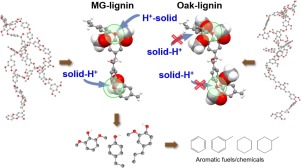当前位置:
X-MOL 学术
›
J. Ind. Eng. Chem.
›
论文详情
Our official English website, www.x-mol.net, welcomes your
feedback! (Note: you will need to create a separate account there.)
Production of phenolic hydrocarbons from organosolv lignin and lignocellulose feedstocks of hardwood, softwood, grass, and agricultural waste
Journal of Industrial and Engineering Chemistry ( IF 5.9 ) Pub Date : 2019-01-01 , DOI: 10.1016/j.jiec.2018.09.009 Deokwon Son , Sangseo Gu , Jae-Wook Choi , Dong Jin Suh , Jungho Jae , Jungkyu Choi , Jeong-Myeong Ha
Journal of Industrial and Engineering Chemistry ( IF 5.9 ) Pub Date : 2019-01-01 , DOI: 10.1016/j.jiec.2018.09.009 Deokwon Son , Sangseo Gu , Jae-Wook Choi , Dong Jin Suh , Jungho Jae , Jungkyu Choi , Jeong-Myeong Ha

|
Abstract Organosolv lignin extracted from the four representative lignocellulose feeds of oil palm empty fruit bunch (agricultural waste), oak (hardwood), pine (softwood) and Miscanthus giganteus (grass) is depolymerized using Ru/H-zeolite β to produce phenolic hydrocarbons. The bulky methoxy functionality, which is rich in oak and pine, sterically hindered the ether bonds, decreasing the yields of phenolic monomers and improving the β–β coupling to repolymerize lignin fragments. Both depolymerization and repolymerization are improved at a higher reaction temperature. The structures and the reaction behavior of organosolv lignin are observed using NMR, GPC, N2-physisorption, SEM and DLS analysis methods.
中文翻译:

从硬木、软木、草和农业废弃物的有机溶剂木质素和木质纤维素原料生产酚类烃
摘要 从油棕空果串(农业废弃物)、橡木(硬木)、松木(软木)和大芒(草)四种代表性木质纤维素原料中提取的有机溶剂木质素,使用 Ru/H-沸石 β 解聚产生酚类烃。橡木和松木中富含的庞大的甲氧基官能团在空间上阻碍了醚键,降低了酚类单体的产率,并改善了 β-β 偶联以重新聚合木质素片段。在较高的反应温度下,解聚和再聚合均得到改善。使用NMR、GPC、N2-物理吸附、SEM和DLS分析方法观察有机溶剂木质素的结构和反应行为。
更新日期:2019-01-01
中文翻译:

从硬木、软木、草和农业废弃物的有机溶剂木质素和木质纤维素原料生产酚类烃
摘要 从油棕空果串(农业废弃物)、橡木(硬木)、松木(软木)和大芒(草)四种代表性木质纤维素原料中提取的有机溶剂木质素,使用 Ru/H-沸石 β 解聚产生酚类烃。橡木和松木中富含的庞大的甲氧基官能团在空间上阻碍了醚键,降低了酚类单体的产率,并改善了 β-β 偶联以重新聚合木质素片段。在较高的反应温度下,解聚和再聚合均得到改善。使用NMR、GPC、N2-物理吸附、SEM和DLS分析方法观察有机溶剂木质素的结构和反应行为。











































 京公网安备 11010802027423号
京公网安备 11010802027423号